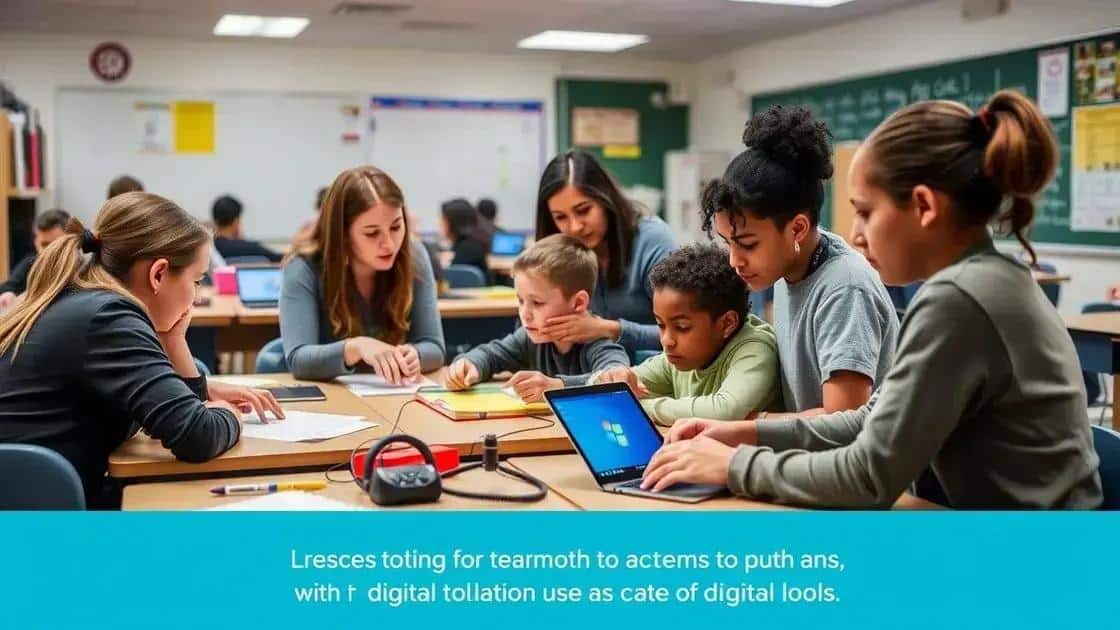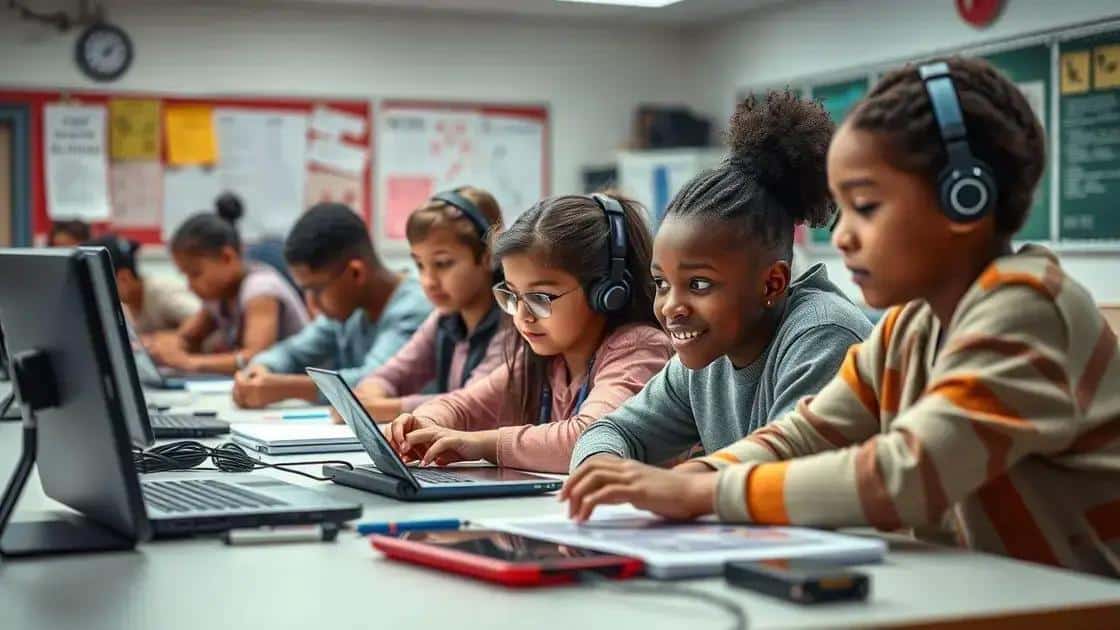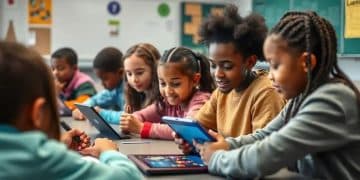Digital literacy curriculum trends shaping the future

Digital literacy curriculum trends emphasize the integration of coding, critical thinking, and adaptive learning, preparing students for the demands of a technology-driven world and fostering responsible online behavior.
Digital literacy curriculum trends are reshaping how we teach and learn in today’s technology-driven environment. Have you noticed how digital skills are becoming crucial in various aspects of life? Let’s delve into the latest trends and their implications for education.
Understanding digital literacy and its importance
Understanding digital literacy is essential in today’s tech-driven environment. It refers to the ability to utilize digital tools and platforms effectively. This skill encompasses a range of competencies, including navigating the internet, evaluating online sources, and communicating through various digital media.
One of the key aspects of digital literacy is its importance in education. Students need these skills to succeed in both their studies and future careers. Digital literacy equips them to handle the challenges posed by an increasingly connected world.
Core components of digital literacy
To grasp the full scope of digital literacy, it’s important to understand its core components:
- Information literacy: This involves the ability to find, evaluate, and use information effectively.
- Media literacy: Recognizing how media shapes views and opinions is crucial.
- Technical proficiency: Comfort with using various digital tools is a must.
- Critical thinking: Analyzing and questioning online content is key to discerning fact from fiction.
Digital literacy also fosters essential life skills. It promotes communication and collaboration, empowering individuals to interact effectively in online environments. Additionally, it helps users protect their privacy and security in an era where information is readily available yet sometimes misleading.
As technology continues to evolve, the need for a well-rounded understanding of digital tools becomes even more critical. Schools and educational programs increasingly emphasize incorporating digital skills into the curriculum. This approach not only prepares students for academic success but also for participation in the modern workforce.
Enabling students to develop these skills opens new opportunities for learning and empowerment. It’s essential for fostering a generation that is well-equipped to navigate the complexities of the digital age.
Key trends in digital literacy curricula

Several key trends in digital literacy curricula are emerging as the world continues to embrace technology. These trends reflect the changing needs of students and the demands of the modern workforce. Schools are adapting their teaching methods to ensure that students are not only consumers of technology but also creators and critical thinkers.
Integration of STEM Education
One major trend is the integration of STEM (Science, Technology, Engineering, and Mathematics) into digital literacy education. Schools are incorporating coding and robotics into their curricula to provide students with hands-on experience. By doing this, students develop problem-solving skills and learn to work collaboratively on projects.
- Robotics programs: These programs engage students in building and programming robots, enhancing critical thinking.
- Coding classes: Teaching programming languages helps students understand how technology works.
- Interdisciplinary projects: Combining subjects allows students to see the real-world applications of digital skills.
Another trend is the emphasis on online safety and digital citizenship. As students interact with digital platforms, understanding how to navigate online spaces safely becomes crucial. Digital citizenship teaches them about responsible online behavior, privacy, and the consequences of their digital footprints.
Personalized Learning Experiences
Schools are also moving towards personalized learning experiences. This approach tailors education to meet the unique needs of each student. Through adaptive learning technologies, educators can provide resources that align with individual learning paces and styles, enhancing engagement.
Digital literacy curricula are becoming more inclusive, focusing on providing equal learning opportunities for all students, regardless of their background. Teachers are being trained to recognize diverse learning needs and to offer support where necessary. Incorporating diverse voices in digital content is also a crucial aspect of this trend.
Finally, collaboration between educators, parents, and technology companies is becoming more common. Schools and families work together to create a supportive environment for students. This collaboration helps ensure that students are exposed to the latest digital tools and resources, equipping them for future success.
How schools are integrating digital skills
Many schools are actively integrating digital skills into their curricula. This approach is essential for preparing students for a technology-driven world. As education evolves, teachers are finding new ways to embed technology in everyday learning.
Project-Based Learning
One way schools are achieving this is through project-based learning. In this model, students work on real-world problems that require digital tools. For example, students might create a website or develop an app as part of their assignments. These projects not only enhance their technical skills but also foster creativity and collaboration.
- Real-world applications: Students learn by solving actual problems.
- Team collaboration: Group projects build teamwork skills.
- Critical thinking: Projects encourage students to think critically about solutions.
Teachers also utilize a variety of digital resources. Online platforms and learning management systems help deliver lessons and track student progress. Tools like interactive whiteboards and educational software enhance engagement and assist teachers in presenting information dynamically.
Professional Development for Educators
To effectively integrate digital skills, schools invest in professional development for educators. Teachers receive training on how to use technology effectively in the classroom. This training prepares them to guide students in using digital tools responsibly and creatively.
Moreover, schools emphasize incorporating digital literacy in all subjects, not just technology classes. For instance, students may use spreadsheets in math or research databases in history. This cross-curricular approach ensures that students see the relevance of digital skills in various contexts.
Finally, parental involvement plays a key role in this integration. Schools often host workshops for parents to share how digital skills are taught and how they can support their children at home. By fostering a home environment where digital learning is valued, schools create a partnership that benefits students.
Future predictions for digital literacy education

The future of digital literacy education looks promising and evolving. As technology advances, schools will need to adapt their teaching methods accordingly. Trends indicate that digital literacy will become a fundamental part of every student’s education, not just an optional subject.
Increased Focus on Coding and Programming
One prediction is the increased focus on coding and programming as essential skills. More schools are likely to integrate coding into their core subjects. This shift will help students understand the mechanics of technology from a young age. It will also prepare them for high-demand careers in the tech industry.
- Early Exposure: Students will start learning coding at earlier ages.
- Hands-On Learning: Practical coding projects will become standard classroom activities.
- Collaboration: Group coding exercises will enhance teamwork skills.
Furthermore, educators will use more adaptive learning technologies. These technologies can customize lessons based on each student’s understanding and pace. This personalized approach will make learning more effective and engaging for diverse learners.
Critical Thinking and Media Literacy
The integration of critical thinking and media literacy into digital curricula will also be crucial. As students are bombarded with information online, they will need to learn how to evaluate sources critically. With effective training, they can differentiate between reliable and unreliable information.
Schools will likely place greater emphasis on teaching students how to use information responsibly. This includes lessons on copyright, ethical online behavior, and the impact of digital footprints. Understanding these concepts will empower students to navigate the digital world safely.
Additionally, global collaboration tools will facilitate learning across borders. Students from different countries may work together on projects through digital platforms, enhancing their cultural awareness and communication skills. This approach will prepare them for a more interconnected world.
Finally, educators will require ongoing professional development to stay current with technological advancements. Schools will provide resources and training for teachers to effectively implement digital literacy strategies in their classrooms.
In conclusion, the future of digital literacy education is bright and evolving. As schools increasingly integrate essential digital skills into their curricula, students will be better prepared for the challenges of the modern world. With a focus on coding, critical thinking, and collaboration, education will equip learners with the competencies they need to thrive. Ongoing professional development for educators and engagement with families will support these efforts. Embracing these changes will create a generation that is not only tech-savvy but also responsible and thoughtful in their digital interactions.
FAQ – Frequently Asked Questions about Digital Literacy Education
Why is digital literacy important for students?
Digital literacy is essential as it prepares students for a technology-driven world, enabling them to navigate, evaluate, and create digital content effectively.
How are schools integrating coding into their curriculum?
Schools are incorporating coding into core subjects through project-based learning, allowing students to engage in hands-on activities that foster technical skills.
What role does critical thinking play in digital literacy?
Critical thinking helps students evaluate the credibility of online information, which is crucial in an age where misinformation can easily spread.
How can parents support digital literacy at home?
Parents can support digital literacy by providing access to technology, encouraging safe online practices, and engaging with their children’s learning experiences.






